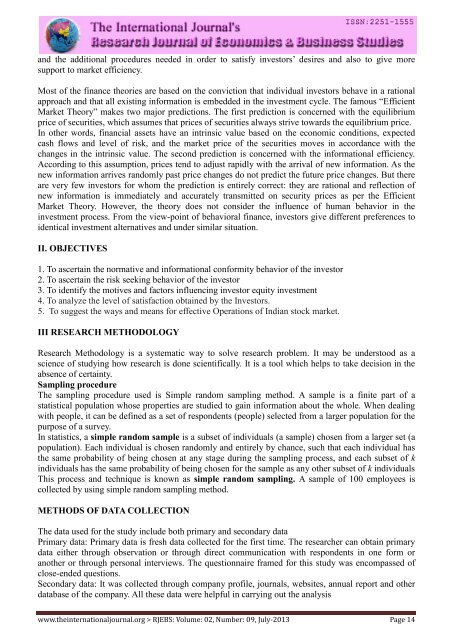Research Journal of Economics & Business Studies - RJEBS - The ...
Research Journal of Economics & Business Studies - RJEBS - The ...
Research Journal of Economics & Business Studies - RJEBS - The ...
Create successful ePaper yourself
Turn your PDF publications into a flip-book with our unique Google optimized e-Paper software.
and the additional procedures needed in order to satisfy investors’ desires and also to give more<br />
support to market efficiency.<br />
Most <strong>of</strong> the finance theories are based on the conviction that individual investors behave in a rational<br />
approach and that all existing information is embedded in the investment cycle. <strong>The</strong> famous “Efficient<br />
Market <strong>The</strong>ory” makes two major predictions. <strong>The</strong> first prediction is concerned with the equilibrium<br />
price <strong>of</strong> securities, which assumes that prices <strong>of</strong> securities always strive towards the equilibrium price.<br />
In other words, financial assets have an intrinsic value based on the economic conditions, expected<br />
cash flows and level <strong>of</strong> risk, and the market price <strong>of</strong> the securities moves in accordance with the<br />
changes in the intrinsic value. <strong>The</strong> second prediction is concerned with the informational efficiency.<br />
According to this assumption, prices tend to adjust rapidly with the arrival <strong>of</strong> new information. As the<br />
new information arrives randomly past price changes do not predict the future price changes. But there<br />
are very few investors for whom the prediction is entirely correct: they are rational and reflection <strong>of</strong><br />
new information is immediately and accurately transmitted on security prices as per the Efficient<br />
Market <strong>The</strong>ory. However, the theory does not consider the influence <strong>of</strong> human behavior in the<br />
investment process. From the view-point <strong>of</strong> behavioral finance, investors give different preferences to<br />
identical investment alternatives and under similar situation.<br />
II. OBJECTIVES<br />
1. To ascertain the normative and informational conformity behavior <strong>of</strong> the investor<br />
2. To ascertain the risk seeking behavior <strong>of</strong> the investor<br />
3. To identify the motives and factors influencing investor equity investment<br />
4. To analyze the level <strong>of</strong> satisfaction obtained by the Investors.<br />
5. To suggest the ways and means for effective Operations <strong>of</strong> Indian stock market.<br />
III RESEARCH METHODOLOGY<br />
<strong>Research</strong> Methodology is a systematic way to solve research problem. It may be understood as a<br />
science <strong>of</strong> studying how research is done scientifically. It is a tool which helps to take decision in the<br />
absence <strong>of</strong> certainty.<br />
Sampling procedure<br />
<strong>The</strong> sampling procedure used is Simple random sampling method. A sample is a finite part <strong>of</strong> a<br />
statistical population whose properties are studied to gain information about the whole. When dealing<br />
with people, it can be defined as a set <strong>of</strong> respondents (people) selected from a larger population for the<br />
purpose <strong>of</strong> a survey.<br />
In statistics, a simple random sample is a subset <strong>of</strong> individuals (a sample) chosen from a larger set (a<br />
population). Each individual is chosen randomly and entirely by chance, such that each individual has<br />
the same probability <strong>of</strong> being chosen at any stage during the sampling process, and each subset <strong>of</strong> k<br />
individuals has the same probability <strong>of</strong> being chosen for the sample as any other subset <strong>of</strong> k individuals<br />
This process and technique is known as simple random sampling. A sample <strong>of</strong> 100 employees is<br />
collected by using simple random sampling method.<br />
METHODS OF DATA COLLECTION<br />
<strong>The</strong> data used for the study include both primary and secondary data<br />
Primary data: Primary data is fresh data collected for the first time. <strong>The</strong> researcher can obtain primary<br />
data either through observation or through direct communication with respondents in one form or<br />
another or through personal interviews. <strong>The</strong> questionnaire framed for this study was encompassed <strong>of</strong><br />
close-ended questions.<br />
Secondary data: It was collected through company pr<strong>of</strong>ile, journals, websites, annual report and other<br />
database <strong>of</strong> the company. All these data were helpful in carrying out the analysis<br />
www.theinternationaljournal.org > <strong>RJEBS</strong>: Volume: 02, Number: 09, July-2013 Page 14
















